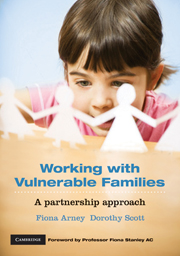Book contents
- Frontmatter
- Foreword
- Contents
- List of figures, tables and boxes
- Contributors
- Acknowledgements
- Introduction
- Chapter 1 Think child, think family, think community
- Chapter 2 Family strengths: an international perspective
- Chapter 3 Harnessing ‘resilience’ when working with children and families
- Chapter 4 Working within and between organisations
- Chapter 5 Family-centred practice in early childhood settings
- Chapter 6 Sustained nurse home visiting with families of Aboriginal children
- Chapter 7 Including fathers in work with vulnerable families
- Chapter 8 Parenting in a new culture: working with refugee families
- Chapter 9 Responding to parents with complex needs who are involved with statutory child protection services
- Chapter 10 Engaging family members in decision making in child welfare contexts
- Chapter 11 Supporting parents whose children are in out-of-home care
- Chapter 12 Using evidence-informed practice to support vulnerable families
- Chapter 13 Spreading promising ideas and innovations in child and family services
- Index
Chapter 7 - Including fathers in work with vulnerable families
- Frontmatter
- Foreword
- Contents
- List of figures, tables and boxes
- Contributors
- Acknowledgements
- Introduction
- Chapter 1 Think child, think family, think community
- Chapter 2 Family strengths: an international perspective
- Chapter 3 Harnessing ‘resilience’ when working with children and families
- Chapter 4 Working within and between organisations
- Chapter 5 Family-centred practice in early childhood settings
- Chapter 6 Sustained nurse home visiting with families of Aboriginal children
- Chapter 7 Including fathers in work with vulnerable families
- Chapter 8 Parenting in a new culture: working with refugee families
- Chapter 9 Responding to parents with complex needs who are involved with statutory child protection services
- Chapter 10 Engaging family members in decision making in child welfare contexts
- Chapter 11 Supporting parents whose children are in out-of-home care
- Chapter 12 Using evidence-informed practice to support vulnerable families
- Chapter 13 Spreading promising ideas and innovations in child and family services
- Index
Summary
Learning goals
This chapter will enable you to:
Recognise the potential of child and family practitioners in health and education settings to engage fathers (and father figures) of vulnerable children in ways that will enhance their ability to nurture and protect their children
Understand how community and staff perceptions, social policy and institutional practices may act as barriers to fathers' participation in child and family settings
Become familiar with recent research evidence pointing to fathers' positive influence on children's well-being and consider the implications of this
Recognise the complexity of changing service procedures and practice to include fathers fully in a way that enhances family well-being
Reflect on the professional and personal challenges that may be faced when attempting to include fathers in services targeting vulnerable children and their families.
Introduction
Involving fathers in the lives of children is consistent with the goals of nearly all family services. Child and family services routinely declare that they wish to form partnerships with parents to ensure the best outcomes for children and most practitioners would consider that having both partners involved in parenting programs is likely to be associated with better outcomes than if services rely on the mother to relay information and ideas to her partner. The reality, however, is that while staff might wish to see fathers involved, when services say parents they usually mean mothers and when evaluators record family involvement in the service it is the mothers' involvement that is assessed.
- Type
- Chapter
- Information
- Working with Vulnerable FamiliesA Partnership Approach, pp. 135 - 156Publisher: Cambridge University PressPrint publication year: 2010



